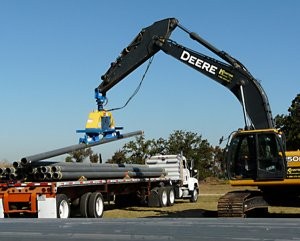
Handling pipe and material on job sites is a labor intensive, time-consuming and potentially-dangerous task, but one that is necessary on water, sewer, utility, and energy pipeline projects. Pipe supplies must be unloaded from trucks, and each section moved into position for placement in the ground. The conventional method for accomplishing that is to strap or chain pipe to an excavator boom or crane to move joints of pipe.
Vacuum lifting uses a powerful vacuum force to unload and position a variety of pipes used on underground construction projects. Vacuum lifting securely holds material, eliminating the need to strap or chain pipe to the lifting boom which prevents material or coating damage that can be caused by other lifting methods.
“Any contractor utilizing vacuum lifting versus traditional methods can expect numerous benefits,” said Shawn Lowman, Director of Sales and Marketing, Vacuworx International. “While the safety of personnel is the primary benefit, it is hard to ignore the efficiency and cost-savings.”
“The Vacuworx system will typically replace what was once being done with chains and manual labor or multiple machines such as forklifts, wheel loaders, excavators and their operators, doing the job faster with one machine and one operator,” Lowman said. “Contractors can decrease load and unload cycles by 7 to 12 times. The vacuum lifting system requires fewer personnel which translates to a reduction in payroll expenses.”
“Vacuum lifting equipment has been routinely used on oil and gas projects for more than a decade, but the benefits of vacuum lifting extend well beyond moving steel pipe,” said Lowman. “Contractors in other industries are discovering that a growing number of applications are suited to the technology.”
“When installing concrete, PVC and ductile iron pipe, a vacuum lifting system can be used to load, unload, string, and join pipe together in the trench, an important safety feature,” Lowman said. “This translates to a much safer job site. If your personnel are not in the trench then the number of job site injuries will drop. Some contractors have reported that they have received a reduction in insurance rates due to having no one in harm’s way when lifting.”
“The introduction of the MC3 Mini in 2009 has created a lot of new applications in vacuum lifting technology. Contractors have welcomed the Mini, especially on the distribution side of the industry,” Lowman said. “The staple for the Mini has been steel pipe up to 12 inches O.D. in 40-foot lengths and smaller, and joints of polypipe.”
“Minis are being used on a lot of concrete culvert work with O.D.s as large as 30 inches. Because concrete culvert pipes are short and weigh less than longer joints of steel pipe, we haven ‘t found a limit on a size the mini can handle.” Lowman said, “MCs also are being used for concrete drop boxes and lids for drainage work. As weights increase, the larger RC10 models (22,000 pounds lifting capacity) may be put in service.”
“The MC3 Mini can be mounted on an excavator, backhoe, wheel loader, forklift, boom truck, or other types of equipment routinely used on construction job sites. For example, it can be pinned to an excavator; has fork pockets for forklifts and loaders; and is available with a picking eye for a crane or knuckle boom type truck.”
“The vacuum unit is controlled from the host vehicle with a closed-frequency wireless remote. Host equipment must have the capacity to accommodate the approximately 800 pounds of the lifter, plus the weight of the material,” said Lowman. “MC3 lifting unit components include the main beam and reservoir; small displacement, one-cylinder gasoline engine vacuum pump, vacuum valve; hydraulic reservoir system; rotator; and vacuum pad.”
“There is a place for vacuum lifting at most job sites. All of our lifters are suitable for utility projects, but due to the weights of materials being lifted, the Mini is certainly the best fit in the water industry.”
Vacuworx manufactures five vacuum lifting units ranging from the MC3 which can lift 6,600 pounds to the RC20 with a lifting capacity of 44,000 pounds. Vacuworx can customize lifters to accommodate a variety of applications and lifting needs.
Whatever the lifting job, Lowman believes vacuum equipment is superior to conventional methods. Several companies currently offer vacuum lifting equipment. Lowman said, “Vacuworx sets itself apart from others by being the only company that specializes in vacuum lifting equipment. Additionally, Vacuworx maintains inventories of equipment and replacement parts, and a 24-hour sales and technical service 365 days a year.”
What Happens If Power Is Lost?
Vacuum lifting offers many benefits, and proponents always emphasize safety as one of the most important.
But what happens if the host machine loses power in mid-lift -- is the load suddenly dropped? A stored supply of vacuum prevents this from happening. “Every Vacuworx lifting system is equipped with a vacuum storage reservoir,” said Shawn Lowman, Director of Sales and Marketing.
“Current safety standards require that the material must be able to be held secure under no power for 10 minutes.” he explained. “At Vacuworx we utilize a 3-to-1 safety ratio, and our systems store enough vacuum in the reservoir to suspend the material between 20-30 minutes, depending on the type of material.”



